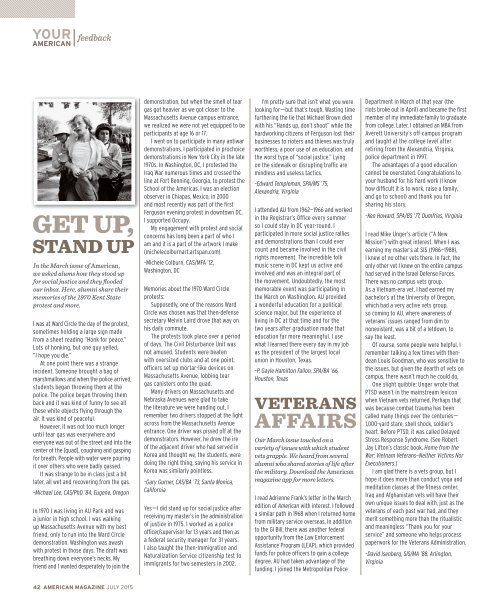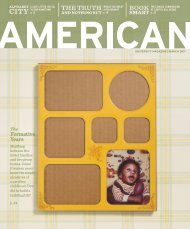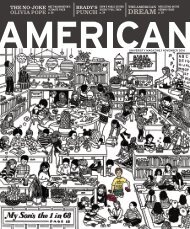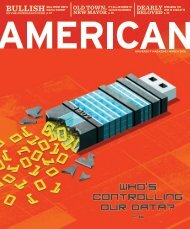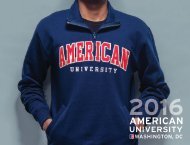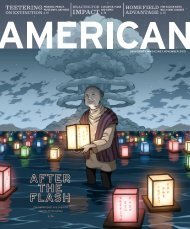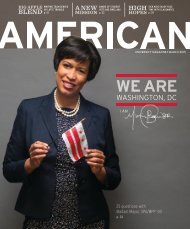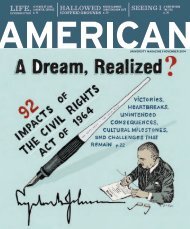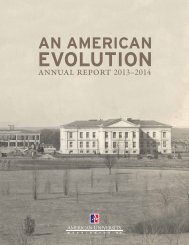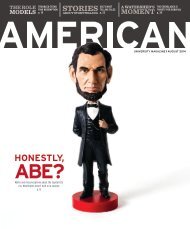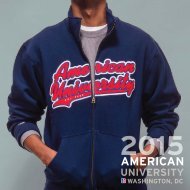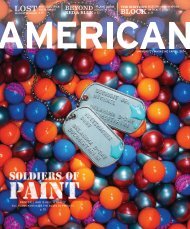American Magazine, July 2015
This issue, meet Maryland First Lady Yumi Hogan, learn about Kogod’s startup incubator, explore the Smithsonian’s new American Enterprise exhibit, hop on the Metro to Navy Yard—Ballpark, and get to know some of AU’s 1,200 Atlanta transplants. Also in the August issue: footwear on campus, 12 Eagles to follow on Twitter, and a new quiz with a tasty prize.
This issue, meet Maryland First Lady Yumi Hogan, learn about Kogod’s startup incubator, explore the Smithsonian’s new American Enterprise exhibit, hop on the Metro to Navy Yard—Ballpark, and get to know some of AU’s 1,200 Atlanta transplants. Also in the August issue: footwear on campus, 12 Eagles to follow on Twitter, and a new quiz with a tasty prize.
Create successful ePaper yourself
Turn your PDF publications into a flip-book with our unique Google optimized e-Paper software.
feedback<br />
In the March issue of <strong>American</strong>,<br />
we asked alums how they stood up<br />
for social justice and they flooded<br />
our inbox. Here, alumni share their<br />
memories of the 1970 Kent State<br />
protest and more.<br />
I was at Ward Circle the day of the protest,<br />
sometimes holding a large sign made<br />
from a sheet reading “Honk for peace.”<br />
Lots of honking, but one guy yelled,<br />
“I hope you die.”<br />
At one point there was a strange<br />
incident. Someone brought a bag of<br />
marshmallows and when the police arrived,<br />
students began throwing them at the<br />
police. The police began throwing them<br />
back and it was kind of funny to see all<br />
these white objects flying through the<br />
air. It was kind of peaceful.<br />
However, it was not too much longer<br />
until tear gas was everywhere and<br />
everyone was out of the street and into the<br />
center of the [quad], coughing and gasping<br />
for breath. People with water were pouring<br />
it over others who were badly gassed.<br />
It was strange to be in class just a bit<br />
later, all wet and recovering from the gas.<br />
–Michael Lee, CAS/PhD ’84, Eugene, Oregon<br />
In 1970 I was living in AU Park and was<br />
a junior in high school. I was walking<br />
up Massachusetts Avenue with my best<br />
friend, only to run into the Ward Circle<br />
demonstration. Washington was awash<br />
with protest in those days. The draft was<br />
breathing down everyone’s necks. My<br />
friend and I wanted desperately to join the<br />
demonstration, but when the smell of tear<br />
gas got heavier as we got closer to the<br />
Massachusetts Avenue campus entrance,<br />
we realized we were not yet equipped to be<br />
participants at age 16 or 17.<br />
I went on to participate in many antiwar<br />
demonstrations. I participated in prochoice<br />
demonstrations in New York City in the late<br />
1970s. In Washington, DC, I protested the<br />
Iraq War numerous times and crossed the<br />
line at Fort Benning, Georgia, to protest the<br />
School of the Americas. I was an election<br />
observer in Chiapas, Mexico, in 2000<br />
and most recently was part of the first<br />
Ferguson evening protest in downtown DC.<br />
I supported Occupy.<br />
My engagement with protest and social<br />
concerns has long been a part of who I<br />
am and it is a part of the artwork I make<br />
(michelecolburnart.artspan.com).<br />
–Michele Colburn, CAS/MFA ’12,<br />
Washington, DC<br />
Memories about the 1970 Ward Circle<br />
protests:<br />
Supposedly, one of the reasons Ward<br />
Circle was chosen was that then-defense<br />
secretary Melvin Laird drove that way on<br />
his daily commute.<br />
The protests took place over a period<br />
of days. The Civil Disturbance Unit was<br />
not amused. Students were beaten<br />
with oversized clubs and at one point,<br />
officers set up mortar-like devices on<br />
Massachusetts Avenue, lobbing tear<br />
gas canisters onto the quad.<br />
Many drivers on Massachusetts and<br />
Nebraska Avenues were glad to take<br />
the literature we were handing out. I<br />
remember two drivers stopped at the light<br />
across from the Massachusetts Avenue<br />
entrance. One driver was pissed off at the<br />
demonstrators. However, he drew the ire<br />
of the adjacent driver who had served in<br />
Korea and thought we, the students, were<br />
doing the right thing, saying his service in<br />
Korea was similarly pointless.<br />
–Gary Gurner, CAS/BA ’73, Santa Monica,<br />
California<br />
Yes—I did stand up for social justice after<br />
receiving my master’s in the administration<br />
of justice in 1975. I worked as a police<br />
officer/supervisor for 13 years and then as<br />
a federal security manager for 31 years.<br />
I also taught the then-Immigration and<br />
Naturalization Service citizenship test to<br />
immigrants for two semesters in 2002.<br />
I’m pretty sure that isn’t what you were<br />
looking for—but that’s tough. Wasting time<br />
furthering the lie that Michael Brown died<br />
with his “Hands up, don’t shoot” while the<br />
hardworking citizens of Ferguson lost their<br />
businesses to rioters and thieves was truly<br />
worthless, a poor use of an education, and<br />
the worst type of “social justice.” Lying<br />
on the sidewalk or disrupting traffic are<br />
mindless and useless tactics.<br />
–Edward Templeman, SPA/MS ’75,<br />
Alexandria, Virginia<br />
I attended AU from 1962–1966 and worked<br />
in the Registrar’s Office every summer<br />
so I could stay in DC year-round. I<br />
participated in more social justice rallies<br />
and demonstrations than I could ever<br />
count and became involved in the civil<br />
rights movement. The incredible folk<br />
music scene in DC kept us active and<br />
involved and was an integral part of<br />
the movement. Undoubtedly, the most<br />
memorable event was participating in<br />
the March on Washington. AU provided<br />
a wonderful education for a political<br />
science major, but the experience of<br />
living in DC at that time and for the<br />
two years after graduation made that<br />
education far more meaningful. I use<br />
what I learned there every day in my job<br />
as the president of the largest local<br />
union in Houston, Texas.<br />
–P. Gayle Hamilton Fallon, SPA/BA ’66,<br />
Houston, Texas<br />
Our March issue touched on a<br />
variety of issues with which student<br />
vets grapple. We heard from several<br />
alumni who shared stories of life after<br />
the military. Download the <strong>American</strong><br />
magazine app for more letters.<br />
I read Adrienne Frank’s letter in the March<br />
edition of <strong>American</strong> with interest. I followed<br />
a similar path in 1968 when I returned home<br />
from military service overseas. In addition<br />
to the GI Bill, there was another federal<br />
opportunity from the Law Enforcement<br />
Assistance Program (LEAP), which provided<br />
funds for police officers to gain a college<br />
degree. AU had taken advantage of the<br />
funding. I joined the Metropolitan Police<br />
Department in March of that year (the<br />
riots broke out in April) and became the first<br />
member of my immediate family to graduate<br />
from college. Later, I obtained an MBA from<br />
Averett University’s off-campus program<br />
and taught at the college level after<br />
retiring from the Alexandria, Virginia,<br />
police department in 1997.<br />
The advantages of a good education<br />
cannot be overstated. Congratulations to<br />
your husband for his hard work (I know<br />
how difficult it is to work, raise a family,<br />
and go to school) and thank you for<br />
sharing his story.<br />
–Ken Howard, SPA/BS ’77, Dumfries, Virginia<br />
I read Mike Unger’s article (“A New<br />
Mission”) with great interest. When I was<br />
earning my master’s at SIS (1986–1988),<br />
I knew of no other vets there. In fact, the<br />
only other vet I knew on the entire campus<br />
had served in the Israel Defense Forces.<br />
There was no campus vets group.<br />
As a Vietnam-era vet, I had earned my<br />
bachelor’s at the University of Oregon,<br />
which had a very active vets group,<br />
so coming to AU, where awareness of<br />
veterans’ issues ranged from dim to<br />
nonexistent, was a bit of a letdown, to<br />
say the least.<br />
Of course, some people were helpful. I<br />
remember talking a few times with thendean<br />
Louis Goodman, who was sensitive to<br />
the issues, but given the dearth of vets on<br />
campus, there wasn’t much he could do.<br />
One slight quibble: Unger wrote that<br />
PTSD wasn’t in the mainstream lexicon<br />
when Vietnam vets returned. Perhaps that<br />
was because combat trauma has been<br />
called many things over the centuries—<br />
1,000-yard stare, shell shock, soldier’s<br />
heart. Before PTSD, it was called Delayed<br />
Stress Response Syndrome. (See Robert<br />
Jay Lifton’s classic book, Home from the<br />
War: Vietnam Veterans—Neither Victims Nor<br />
Executioners.)<br />
I am glad there is a vets group, but I<br />
hope it does more than conduct yoga and<br />
meditation classes at the fitness center.<br />
Iraq and Afghanistan vets will have their<br />
own unique issues to deal with, just as the<br />
veterans of each past war had, and they<br />
merit something more than the ritualistic<br />
and meaningless “Thank you for your<br />
service” and someone who helps process<br />
paperwork for the Veterans Administration.<br />
–David Isenberg, SIS/MA ’88, Arlington,<br />
Virginia<br />
42 AMERICAN MAGAZINE JULY <strong>2015</strong>


